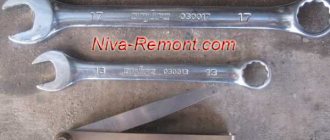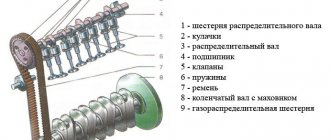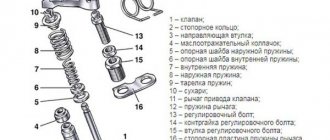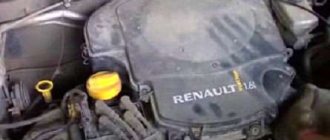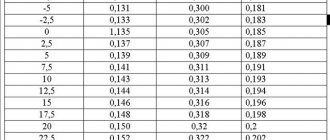The VAZ classic family cars: 2101, 2102, 2103, 2104, 2105, 2106, 2107, 2121, 2123, 2131, 21053, 21213, 21214 have a four-stroke engine.
The carburetor was installed on the engines of Zhiguli cars until 2000 and subsequently, after a simple modernization, an injector was used on cars 2105 and 2107. This is an in-line engine with vertically arranged cylinders in a block. The channels of the cooling system in the cylinder block are made along the entire height of the cylinders, effectively cooling the piston group, piston rings from “stagnation”, and also preventing deformation of the cylinder block from local heating.
The crankshaft is located at the bottom of the cylinder block on five main sliding bearings. Oil seals made of oil-resistant rubber are used as seals to prevent oil leakage.
An important engine component is the cylinder head. It is a complex cast aluminum alloy block with valve seats and guide bushings pressed into it. The cylinder head contains a cooling jacket and oil passages for supplying lubricant under pressure to the camshaft bearings and rockers that drive the valves.
Oil seals are installed on the valves to prevent oil from entering the combustion chamber. A total of 8 valves are used.
The camshaft is mounted on the cylinder head and is driven by a double-row chain from the crankshaft. Semi-automatic chain tensioning device, powered by a spring. It is possible to install a device for automatic chain tensioning, the rod of which adjusts its position based on the oil supply under pressure.
Unlike the UMZ engine installed on Gazelle, Volga, UAZ cars, the transmission of movement to the valves from the camshaft is carried out through levers (rockers), without the use of rods and rocker arms. The OHC rocker system ensures stable operation of the valves at idle and at high crankshaft speeds, reducing the ringing noise of their operation.
Adjusting valves of VAZ 2106, 2107, etc. According to the maintenance instructions, it is performed every 10,000 km and, due to the simple and compact layout of the engine, there are no difficulties in the procedure.
Getting started and disassembling
Before starting work related to adjusting the thermal clearances of the valves, it is necessary to prepare the engine, tools and related materials.
Secure the car with the handbrake and move the gearbox to neutral. For safety reasons and to prevent independent movement, additionally install shoes under the wheels. Open the hood and check the engine temperature, which should be approximately 20 degrees to carry out the valve adjustment process.
As an exception, there is a correction table for valve clearances depending on engine temperature, but given the unpredictable deformations of the metal structure, we recommend adjusting at the temperature specified in the manufacturer's instructions. It is at a temperature of 20 degrees that the metal structure is in a stable state, without noticeable thermal linear expansion or contraction (negative temperatures).
Before disassembling parts and assemblies to provide access to the valve regulation operation, turn off the power to the on-board electrical network of the machine by disconnecting the negative terminal of the battery.
Further operations for preparing the gas distribution mechanism of a carburetor engine differ from those of an injection engine.
On a carburetor engine:
- Unfasten the retaining spring latches of the air filter housing cover or unscrew the wing nut;
- Remove the cover and put the air filter element aside;
- Using an “8” socket or an open-end wrench, unscrew the four nuts holding the air filter housing on the top of the carburetor and move it to the side, separating it from the crankcase ventilation pipe;
- Remove the carburetor choke drive cable by partially unscrewing the half-clamp holding the cable sheath and the cable rod clamp;
- Using a slotted screwdriver, unfasten the plastic ends of the accelerator pedal drive on the carburetor and, by removing the locking ring from the drive axis mounted on the valve cover, remove the rod.
On an injection engine:
- Remove the limiter (in the form of a bracket) for spontaneous release of the cable from the throttle linkage groove.
- Turn the throttle linkage counterclockwise and pull the cable tip to the side;
- Unscrew the two bolts holding the accelerator cable assembly bracket with a 10mm head;
- If there is an adsorber, remove the connector on the purge valve;
- Loosen the clamps on the air duct and gas ventilation pipes, unscrew with a “10” head the bolt securing the plastic sleeve of the pipes on the valve cover and remove them;
Using a “10” socket, unscrew the eight bolts securing the valve cover and remove it from the block head. Inspect the parts of the gas distribution mechanism for damage and the condition of the springs.
How to adjust valves on a VAZ 2106: step-by-step instructions
Split camshaft gear: what is it for?
Adjusting the valves on the VAZ 2106 will require mandatory adherence to the entire sequence of actions, the use of appropriate simple tools and careful preliminary preparation.
This kind of work is not difficult, so it can be done even without much practical experience in repairing and servicing VAZ engines. You just need to take into account the order of valve adjustment, which depends on the specific engine modification.
To adjust the valves on a VAZ 2106, you will need the following tools:
- crankshaft key;
- micrometer or adjustment probe;
- flat blade screwdrivers;
- socket wrenches;
- valve cover gasket.
In the car tool kit you can find a special probe with a thickness of 0.15 millimeters. On relatively fresh, unworn engines, the use of such meters allows you to set the valve clearance as accurately as possible, significantly simplifying repair work. However, subsequently, as the seats wear out, the distance changes, and it may no longer be possible to ensure the adjustment of the gap using standard feeler gauges that come with the car’s tool kit. Therefore, experts recommend using a micrometer, which guarantees maximum quality of such work.
Preparatory stage
The quality of the work performed and the absence of car engine breakdowns subsequently depend on how correctly the preparatory stage is completed. The easiest way to adjust valve clearance is in a garage or any other enclosed and well-lit room.
The preparatory stage involves the following work:
- Place stops under the rear drive wheels and engage neutral on the gearbox.
- Open the hood and wait for the engine to cool, which usually takes about half an hour.
- Disconnect the battery, which will eliminate the possibility of a short circuit in the electrical wiring.
- Remove the carburetor cover and unwind the gas pedal cable.
- Loosen the cylinder head by using a 10mm wrench.
- Carefully remove the cylinder head, remembering the location of each mounting pin.
It would be useful to additionally check the correct tension of the timing chain. Wear of the gas distribution mechanism drive can lead to extraneous knocking noises when the engine is running. In the worst case, when the chain teeth slip, the piston, moving at high speed, crashes into the valves, completely destroying the engine. Car owners with such breakdowns face expensive and complex engine overhauls.
Step-by-step adjustment of gaps
Having properly prepared the engine for service and checked the timing belt tension, you can begin adjusting the valves.
It will also be interesting: GAZ 24 engine and its features
All work is performed according to the following algorithm:
- Adhering to the position and focusing on the marks on the timing belt, you should use a micrometer to make sure that there are no gaps on valves number 8 and 6.
- To check the clearance you will need to place a feeler gauge on top of the rocker under the camshaft. If the control plate fits freely into the hole, then you need to unscrew the adjusting bolt and unscrew the lock nut.
- In the same way, by aligning the marks on the crankshaft, valves 4 and 7, 1 and 3, 5 and 2 are adjusted. This routine will remain on all 2106 engines.
The rotation angle of the crankshaft during inspection is 0, 180, 360 and 540 degrees. After each rotation of the shaft, you should check the corresponding marks, which will not only allow you to carry out the adjustment correctly, but will also eliminate any problems with the power unit in the future. With a certain amount of skill, this kind of work can be done in literally 15-20 minutes. You just need to be extremely careful, constantly checking that the marks on the crankshaft match. Using a feeler gauge or micrometer, you can ensure accurate valve clearances.
All that remains is to reinstall the valve cover head in reverse order, not forgetting to use a new gasket. The fixing bolts on the cylinder head cover must be tightened in full accordance with the recommendations of the vehicle instructions. The latter will ensure the tightness of the combustion chamber and guarantee a tight fit to the cylinder head and cylinder jacket.
Valve adjustment process
The procedure for adjusting valve thermal clearances is the same for carburetor and injection engines. The only difference is the thermal clearance of the valves. On a carburetor engine, the clearances on all valves are set to 0.15 mm when the engine is cold, and on an injection engine, 0.20 mm. Adjustment begins with setting marks on the crankshaft and camshaft.
By turning the nut securing the belt drive pulley (drive disc on an injection engine) with a special wrench to “38”, we align the mark in the form of a mark on the pulley with the protrusion on the front cover, while the mark on the camshaft sprocket should coincide.
In this position, the piston of the fourth cylinder is at TDC (00 kV) and the eighth and sixth valves are adjusted (numbering from 1st to 8th starts from the radiator).
For this:
- the dipstick is inserted between the camshaft cam and the working surface of the valve lever;
- use key 17 to loosen the locknut to allow free movement of the adjusting bolt;
- by rotating the adjusting bolt with wrench 13, achieve a gap value at which the feeler gauge will move with little effort;
- holding the wrench 13 against turning the adjusting bolt, tighten the locknut.
It must be borne in mind that when tightening the lock nut, the resulting gap may “move” to a larger or smaller direction, so it is important to re-check the thermal gap after fixing the adjusting bolt.
The next pair of valves is adjusted by turning the crankshaft by 1800, while the camshaft sprocket will rotate by 900. The mark on the sprocket will be located at the cut of the junction of the lower and upper camshaft beds.
In this position the fourth and seventh valves are adjusted.
By positioning the crankshaft 360 degrees, the first and third valves are adjusted. And in the position of the shaft set at 540 degrees, the fifth and second are subject to adjustment.
Payment
Payment to a Sberbank VISA card The most convenient and profitable payment method for you. Payment can be made through the Sberbank Online system, through a payment terminal (Sberbank ATM), provided that you have a card from this bank. If you are not a client of this bank and you do not have a card, then you can top up your balance at any bank branch through an operator; they will accept cash payment and top up your balance. Commission from 0 to 1%
Cash on delivery (payment upon receipt) Payment for the order will be made at the post office upon receipt of the goods. For cash on delivery services, Russian Post takes an additional commission - approximately 4% of the cost of the order (parcel) upon receipt. In addition to the delivery cost, the post office will also charge you a commission for the cash on delivery service.
Cashless payment This type of payment is suitable for organizations and individual entrepreneurs. An invoice for payment is generated after placing an order. A specialist will contact you to clarify details.
Cash payment You can pay in cash directly in the store, when picking up the goods.
Adjustment order table:
On a carburetor engine, to more accurately determine the position of the camshaft, it is possible to use a distributor, the slider of which is directed to the socket of the high-voltage wire of the corresponding cylinder. If the distributor cover is removed, then four screws on the housing that coincide with the sockets of the high-voltage wires can serve as a guide.
You can also use the distributor with the cover removed: connect a control light to the low-voltage circuit and turn the crankshaft with the ignition on. The moment the light turns on indicates the exact position of the camshaft at which the corresponding pair of valves is adjusted.
How is the procedure performed?
The car must be placed on a flat surface and a tool for turning the crankshaft (ratchet) must be prepared. If this is not the case, then you can get by with a jack. We will turn the crankshaft using muscle force - rotate the wheel in fourth gear.
Before opening the valve cover, you need to tighten the timing chain. All activities related to adjusting any parts of the engine should begin with this.
Loosen the tensioner nut 13 and turn the crankshaft 2-3 turns. After this, tighten the nut. The tension device performed all the necessary manipulations.
Two-step technique
There is a simplified method for adjusting valves in two steps.
- Set the crankshaft to top dead center.
- We combine the marks on the camshaft and the shaft bed.
- We adjust the 4th, 6th, 7th, and 8th valves.
- Immediately after this, turn the crankshaft a full turn.
- We adjust the 1st, 2nd, 3rd and 5th valves.
The two-turn adjustment technique allows you to reduce the time for servicing the gas distribution mechanism, and is also convenient for beginners to carry out this procedure with their own hands.
On a Chevrolet Niva car and a number of Niva cars, the thermal valve clearances are adjusted automatically by hydraulic compensators.
Where is the noise coming from?
As the gap grows, the cam hits the rocker, and the driver will hear characteristic noises. These valve clearances must comply exactly with the vehicle manufacturer's recommendations. And noise is just a small part of the many side effects of incorrect clearances. If the valves are worn out, then the rocker itself wears out, and then the camshaft cams. This way, the cam will hit the rocker rather than push it smoothly. Any car owner should know how to adjust valves.
Adjustment Tools
The adjustment procedure begins with disassembling the valve cover and parts that prevent access to it.
Necessary tools for preparing the gas distribution mechanism for adjustment:
- 1/2 inch ratchet wrench with extension and socket for “10” and “8”;
- universal screwdriver;
- pliers.
To adjust the thermal clearances of the valves, the following tool is required:
- Ratchet key to “38”;
- Open-end wrench 17;
- Open-end wrench 13;
- The probe is 0.15 mm thick (for an injection engine - 0.20 mm).
Valve lid
Owners of the VAZ 2105, like other classic models, often encounter the problem of an oily engine. An unpleasant situation can manifest itself in the form of both small and significant leaks, which indicates failure of the valve cover gasket. Replacing the seal is not a complicated undertaking and will require a minimum of effort and tools, such as:
- flat screwdriver;
- wrench 10;
- ratchet wrench 10.
Replacing the valve cover gasket on a VAZ 2105
We carry out the work of replacing the valve cover seal on the “five” in the following sequence:
- To free access to the cover, remove the air filter and the housing, which is attached to the carburetor.
Valve cover tightening procedure
To avoid distortions when installing the valve cover, the nuts must be tightened in a certain order, as can be seen from the figure below.
The appearance of any malfunctions or even their signs associated with wear of the valve seals or the valves themselves should not be ignored. If you replace a failed part or make the necessary adjustments in a timely manner, you will be able to avoid costly engine repairs. Therefore, it is important to monitor the technical condition of the power unit and perform the necessary maintenance according to the manufacturer’s recommendations.
vote
Article rating
Adjustment with a micrometer
The most accurate method for regulating valve thermal clearances is to use a device with a dial indicator - a micrometer. A micrometer is a very sensitive device that responds to changes in the translational movement of its measuring rod every hundredth of a millimeter.
The procedure is similar to the order of adjustment using a feeler gauge. The peculiarity of this method is to install a rail on the studs of the camshaft bed, onto which a micrometer is attached. The rack contains information on the angles of the crankshaft position to the valves corresponding to adjustment.
Before starting work, the micrometer is mounted on a device that has a lever in the form of a rocker arm. One side of the lever rests on the micrometer rod with a light touch, and the other on the extreme part of the rocker. By lifting the rocker without force with a special “spade” until it touches the back side of the camshaft cam, note how many divisions the arrow has deviated from the zero position. For a carburetor engine, the needle should deviate by 52 divisions.
A micrometer for adjusting valves is supplied with a description and all necessary accessories.
A homemade rail can be made according to a factory design. With the help of such a rack, the actions when independently adjusting the valves are more confident and there is no need to remember the routine or sequence of operations.
About choosing styli
Uneven knocking noises in the area of the upper part of the valve cover indicate increased clearances. According to the instructions for setting the VAZ-2106 valves, they can be adjusted. The gaps are changed using special feeler gauges for classic VAZ models. These probes are wide. The standard set of feeler gauges is narrow and cannot cover the entire width of the gap in the operating area of the pressure levers and camshaft cams. This will not allow you to accurately determine whether the gap is correct. On the case in which the dipstick is sold, there is a diagram for adjusting the valves in the form of a convenient table.
Consequences of untimely adjustment
Untimely maintenance of the gas distribution mechanism negatively affects engine performance, causing unbalanced operation. The engine runs rough, there is no traction performance, and fuel consumption increases. It is known that the injection phase is directly dependent on the thermal clearance of the valves. Correct and correct adjustment allows the valves to open and close in a timely manner. If the gap is set less than the permissible value, then the valve begins its operation with some advance, and vice versa, if the gap is large, it opens late. Reduced clearance on exhaust (hot) valves increases the time they remain open, which can cause the edges to slowly burn out, leading to loss of compression in the cylinder.
When operating the engine on gas (propane or methane), the thermal clearances must be adjusted with the same gaps, the value of which is determined by the instructions for operating the engine on gasoline. Adjusting the valves for gas does not have scientific and technical validity and can lead to unstable engine operation.
Features of timing belt
For example, the gas distribution mechanism - with the upper position of the valves and camshaft. shaft The timing drive of the engine was carried out via a chain, and this is on all models.
A special feature of the valve mechanism is the use of push levers, also known as rockers. They are located between the camshaft and the end of the valve stem. That is, the cam acts on the valve not directly, but through the rocker. Also, thanks to the push lever, it is possible to adjust the thermal gap.
This gap is needed in order to compensate for the change in the geometric parameters of the constituent elements of the valve mechanism that occurs as a result of heating, during which the metal expands. If this gap did not exist, then after heating the power plant there would be a violation of the valve timing. To put it simply, when heated due to the expansion of the metal, the valves do not close completely, which leads to loss of compression and, as a result, a drop in power.
The list of maintenance work for the power plants of these models included such an operation as adjusting the valves. This is due to the design features of the valve mechanism. During operation, the working surfaces of the valve end, rocker and camshaft cams are erased, which leads to a violation of the thermal clearance.
Fortunately, the same design is quite simple, so the adjustment work is quite simple and you can do it yourself. It is only important to know the order of work and the sequence of adjusting the valves on the “Classic”. It is noteworthy that the operation is identical for almost all models, so the procedure for adjusting the valves of the VAZ-2101 and, for example, the VAZ-2105 is the same, only in the VAZ-2107 it is slightly different.
Since for most models the operation is done identically, then all Zhiguli models belonging to the “Classics” will appear below.
The first and basic rule of the operation is that it is performed only on a cooled engine. This is due to the same expansion of the metal. If the valve adjustment on a VAZ-2102 or any other model is done on a heated unit, then the operation will not give a positive result, because when it cools, the metal will return to its original shape and the gap will not correspond to the norm, it will simply increase.
You also need to know when the VAZ-2105 valves should be adjusted. A sure sign that the valve mechanism is out of adjustment is a loud metallic knock from the engine compartment when the engine is running. Moreover, its intensity changes in proportion to the increase or decrease in speed.
Adjustment of valves on the VAZ-2104 must also be carried out every time repair work is carried out on the cylinder head associated with removing the camshaft.


